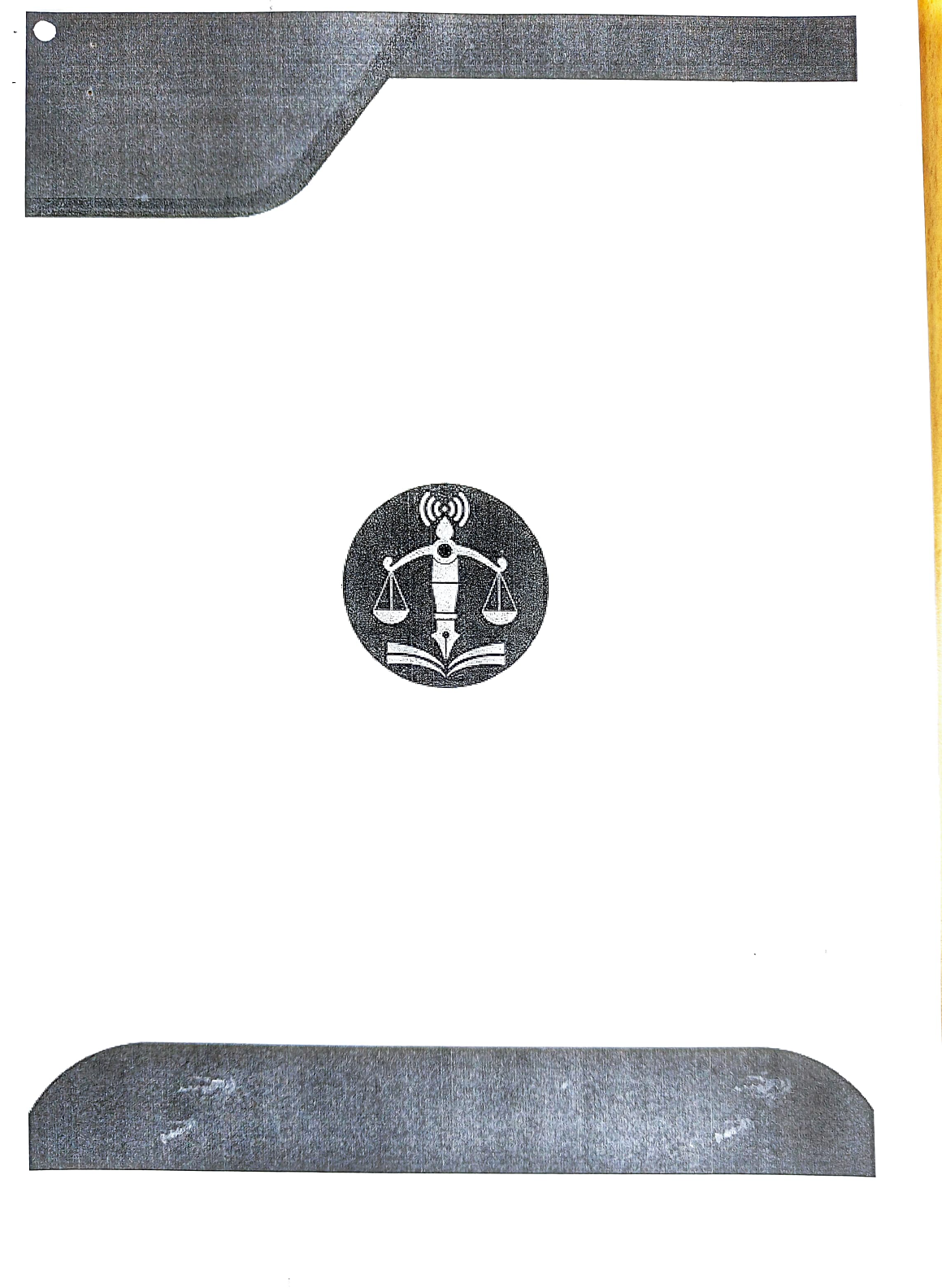
Annexure
-A
()
Standard Operating
Procedure
for
Preparing Accessible
Court
Documents
E-Committee,
SUpreme
Court
of
India
2022
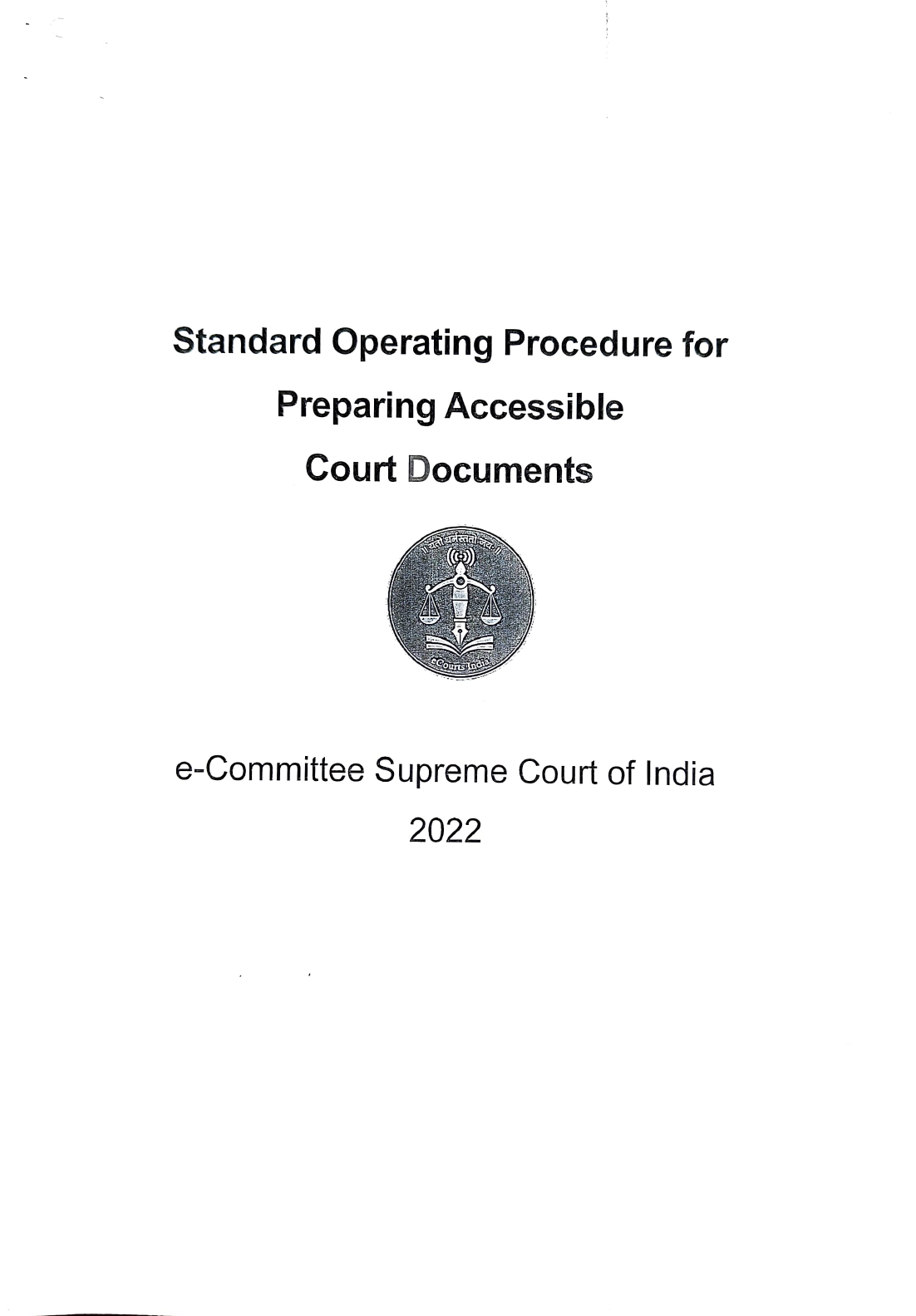
Standard
Operating
Procedure
for
Preparing
Accessible
Court Documents
e-Committee
Supreme
Court
of
India
2022
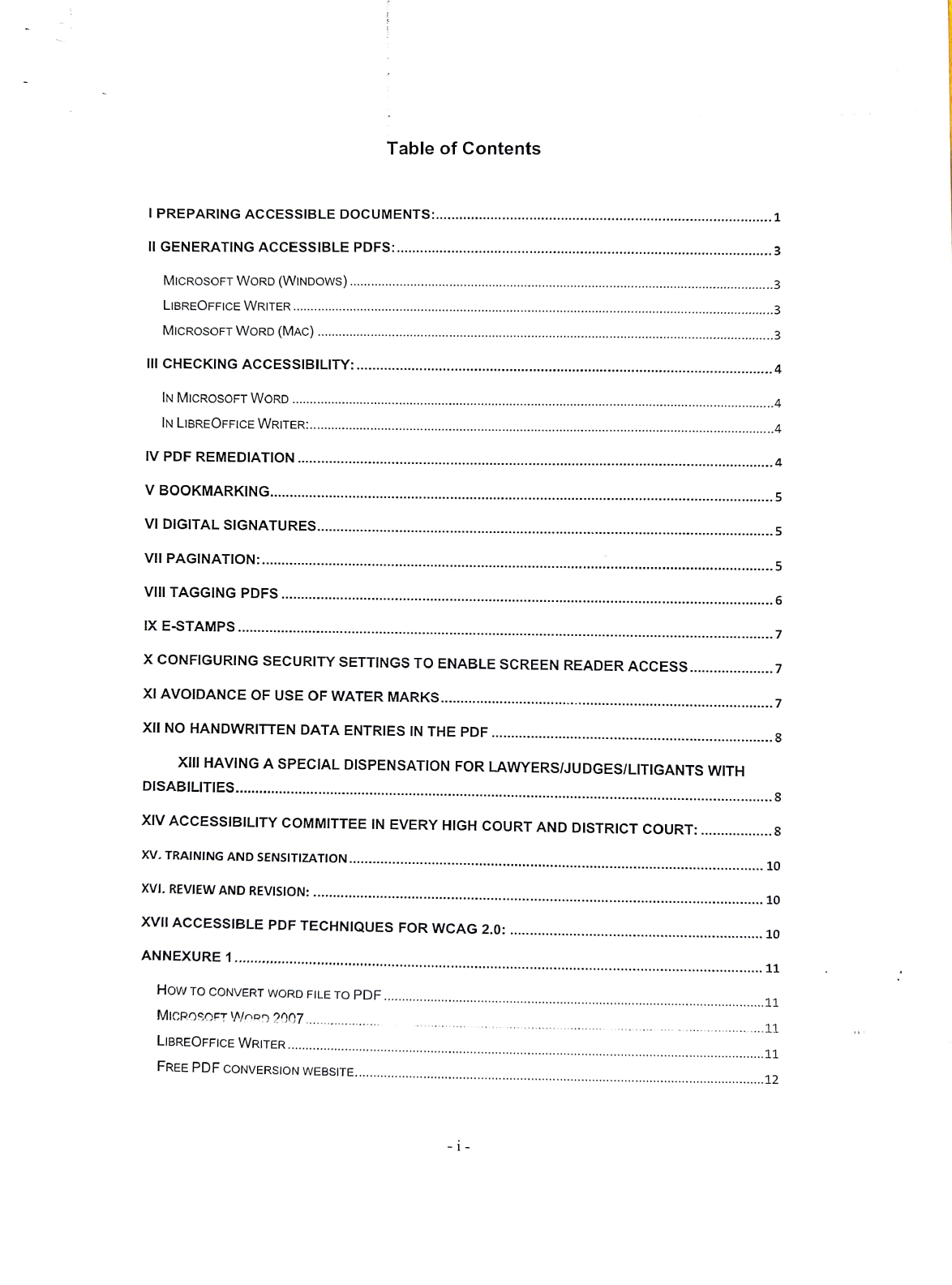
I
PREPARING
ACCESSIBLE
DOCUMENTS:..
I|
GENERATING
ACCESSIBLE
PDFS:
MICROSOFT
WORD
(WINDOWs).
LIBREOFFICE
WRITER
MICROSOFT
WORD
(MAC)
II
CHECKING
ACCESSIBILITY:...
IN
MICROSOFT
WORD
IN
LIBREOFFICE
WRITER:.
IV
PDF
REMEDIATION
V BOOKMARKING.
VI
DIGITAL
SIGNATURES.
VII
PAGINATION:.
VIlI
TAGGING
PDFS
IX
E-STAMPS
X
CONFIGURING
SECURITY
SETTINGS
TO
ENABLE
SCREEN
READER
ACCESS...............
XI
AVOIDANCE
OF
USE
OF
WATER
MARKS.
XII
NO
HANDWRITTEN
DATA
ENTRIES
IN
THE
PDF
XIIl
HAVING
A
SPECIAL
DISPENSATION
FOR
LAWYERSIJUDGESILITIGANTS
WITH
DISABILITIES.
Table
of
Contents
XIV
ACCESSIBILITY
COMMITTEE
IN
EVERY
HIGH
COURT
AND
DISTRICT
COURT:
XV.
TRAINING
AND
SENSITIZATION.
XVI,
REVIEW
AND
REVISION:
XVII
ACCESSIBLE
PDF
TECHNIQUES
FOR
WCAG
2.0:
ANNEXURE
1...
How
TO
CONVERT
WORD
FILE
TO
PDF
MICROSOFT
WOen
2007
LIBREOFFICE
WRITER.
FREE
PDF
CONVERSION
WEBSITE..
-j
1
3
3
3
4
5
6
7
7
10
10
10
11
.11
....11
.11
.12

ANNEXURE
2..
CREATING
AcCESSIBLE
SCANNED
DOcUMENTS
(PDF
REMEDIATION)
PROCESSs
OF
CREATING
AN
ACCESSIBLE
SCANNED
DOCUMENT
IN
ACROBAT
PRO:
OPEN-SOURCE
SOFTWARE
FOR
PDF
REMEDIATION:.
-
ij
-
13
13
......13
13

Procedure
for
Preparing Accessible Court Documents:
IPreparing
Accessible
Documents:
1.
The
original
text
material
and
documents
[including
main
petition
or
appeal,
interlocutory
applications
etc.]
can
be
prepared
electronically
using
Microsoft
Word
or
LibreOffice
Writer
software.
2.
When
creating a document, there are a
few
basic steps that
should
be
followed
in
order
to
ensure
the
document
is
accessible.
The
core
steps
needed
for
accessibility
are:
a.
Use
headings
(Build-in
Heading
styles
available
in
Styles
tab
must
be
used).
i.
Headings
should
form
an
outline,
using
the
"Heading
1"
style
for
the
main
heading,
and
"Heading
2"
for
sub-headings.
If
there are
additional
levels
of
headings
within
the
document's
outline,
using
"Heading
3",
"Heading
4",
etc.
b.
Use
lists
(Build-in
lists
styles
must
be
used)
c.
Use
meaningful
hyperlinks.
Ensure
that
the
text
of
the
hyperlink
serves
the
purpOse.
d.
Provide
an
image
description
of
pictorial
evidence.
In
other
words,
add
'Alt
Tag'
to
images,
shapes,
smart
art
or
charts.
e.
Using
accessible
fonts:
These
include
Arial
and
Calibri.
Font
size
13.
Line
spacing
1.5.
Gap
between
two
paragraphs
should
be
20
cm.
Cursive
fonts
should
not
be used.
f.
For
newspaper
cuttings
and
other
forms
of
evidence
that
are
illegible/
ímage-based,
provide
a
plain
text
transcript
of
the
same.
g.
Text
in
the
document
should
not
be
underlined,
as
it
hampers
smooth
access
for
the
disabled.
-|
-

h.
All
capitals
in
the
text,
mostly
used
in
title
of
the
applications
are
also
a
challenge
to
accessibility
of
text.
Thus
sentence
case
should
be
used
and
small caps
should
be
avoided.
i.
The
paragraphs
in
the
document
should
be
left-aligned.
Although
justified
text
may
look
more
visually
appealing,
it
must
be
avoided
as
extra
spaces
within
lines
make
it
inaccessible
for
users.
j.
Identify
document
language.
k.
Use
tables
wisely,
by
clearly
labelling
column
and
row
headers.
The
headers
must
be
in
the
first
row
only.
If
need
be,
more
detailed
labelling
for
CSV
type
formatting
would
be
good
[e.g.
spreadsheets
found
on
data.gov.in].
Do
not
use
'merged
cells'
or
split
cells'
or
do
not
put
in
blank lines.
Regional/vernacular
content
must
be
rendered
in
unicode
font.
m.
Use
sufficient
colour
contrast
between
the
foreground
text
and
background
colour.
Use
accessibility
checker
or
applications
like
Color
Contrast
to
analyse
the
document
for
insufficient
colour
contrast.
n.
Use
the
Accessibility
Checker
for
ensuring
that
the
document
contains
no
errors
or
warnings.
3.
The
documents should
be
converted
into
Portable
Document
Format
(PDF)
using
any
PDF
converter
or
in-built
PDF
conversion
plug-in
provided
in
the
software.
The
process
of
converting
word
file
to
PDF
is
provided
in
Annexure
1.
4.
Fonts
in
PDF
documents
should
not
be
compressed.
To
this
end,
when
optimizing
PDFs
for
size,
ensure
that
this
is
done
without
un-embedding
the
fonts
or
their
subsets.
When
compressed
fonts
are
used, the
screen
reader
used
by
the
visually
challenged
reads
multiple
words
together,
without
spaces.
For
instance,
"It
Can
be
Done"
is
read
as
"itcanbedone".
Letter
spacing
should
be
used,
so
that
different
characters
can
be
distinguished
from
one
another.
Otherwise,
for
instance,
n
used
-2
together,
without
spacing,
can
be
mistaken
for
the
letter
"m".

5.
Documents
in
Electronic
Publication
[EPUB]
format
make
for
a
more
conducive
reading
experience.
To
the
extent
possible,
all
documents
should
be
made
available
in
EPub
format.
6.
Documents prepared
using
automatic
workflow
methods, such as
dynamic
PDFs,
must
be
made
accessible
to
persons
with
disabilities.
I|
Generating
Accessible
PDFs:
Microsoft
Word
(Windows)
7,
Go
to
File
> "Save AS..." and select
PDF
from
the choices provided.
By
default
this
produces a
PDF
that preserves
the
document's accessibility
features.
8.
When saving, select Options and be sure that "Document structure tags
for
accessibility"
is
checked.
This
is
checked
by
default
but
could
become
unchecked
under
certain
circumstances.
9.
If
you
select
"Minimize
Size'
to
reduce the size
of
your PDF,
be
sure
to
repeat
the
preceding
step,
as
this
option
might
uncheck
the
"Document
structure
tags
for
accessibility"
checkbox.
LibreOffice
Writer
10.
Open
the
file
you
wish
to
save.
Go
to
"File"
>
"Export
As">
"Export
as
PDF".
It
will
open
PDF
options
window.
Select
"Archive
(PDFIA)Y",
"Universal
Accessibility
(PDF/UAY"
and
"Tagged
PDF
(add
document
structure)'
options.
Click
the
Export
button.
This
will
create
PDF
file.
Microsoft
Word
(Mac)
11.
Go
to
File
>
"Save
As..."
and
select
PDF
from
the
choices
provided.
By
default
this
produces
a
PDF
that
preserves
the
document's
accessibility
features.
-3
-

12.
When
saving,
be
sure
the
radio
button
labelled
"Best
for
electronic
distribution and accessibility"
is
selected.
IlII
Checking
Accessibility:
In
Microsoft Word
Select
Review
Tab
->
Select
Check
Accessibility.
Note:
the
precise
way
to
access
the
'check
accessibility'
option
may
change
in
future
versions
of
Microsoft
Word
or
LibreOffice
Writer.
In
LibreOffice Writer:
Select Tools Tab
->
Select Accessibility Check.
For
activating
the
"Accessibility
Check"
feature,
the
experimental
features
has
to
be
enabled
for
LibreOffice.
Review
your results.
You'll
see
list
of
errors, warnings, and tips
with
how-to
fix
recommendations
for
each.
IV
PDF
Remediation
13.
In
exceptional
circumstances,
for
instance
where
certain
documents
that
are
to
be
enclosed
are
originally
in
hard
copy
form
and
have
to
be
scanned,
they
must
be
in
Optical
Character
Recognition
(0CR)
enabled
PDF
format.
They
should
not
be
scanned
using
poor
quality
solutions
like
Cam
Scanner,
or
by
taking
pictures
of
the
physical
copy.
The
document
should
be
scanned
using
an
image
resolution
of
300
dpi
(dot
per
inch).
This
exception
of
scanning
documents
is
only
allowed
if
the
document
that
is
to
be
scanned
is
legible
and
has
not
been
electronically
prepared
using Microsoft
Word
or LibreOffice Writer Software
by
the advocate or
the
party
concerned.
If
the
document
is
illegible,
it
must
be
typed
and
- 4
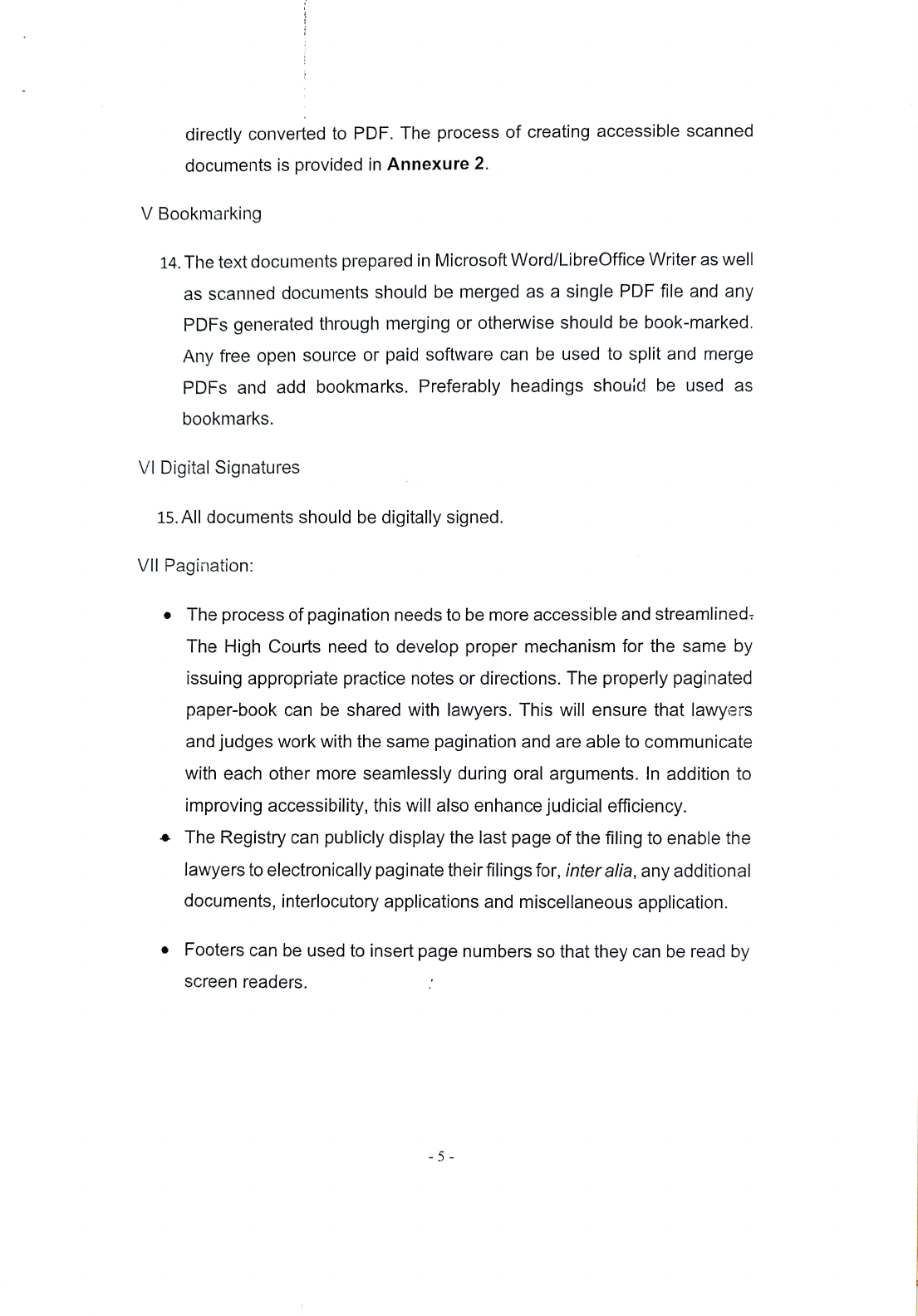
directly
converted
to
PDF.
The
process
of
creating
accessible
scanned
documents
is
provided
in
Annexure
2.
V
Bookmarking
14.
The
text
documents
prepared
in
Microsoft
Word/LibreOffice
Writer
as
well
as
scanned
documents
should
be
merged
as
a
single
PDF
file
and
any
PDFs
generated
through
merging
or
otherwise
should
be
book-marked.
Any
free
open
source
or
paid
software
can
be
used
to
split
and
merge
PDFS
and
add
bookmarks.
Preferably headings
shouid
be
used
as
bookmarks.
VI
Digital
Signatures
15.
All
documents should
be
digitally
signed.
VII
Pagination:
"
The
process
of
pagination
needs
to
be
more
accessible
and
streamlined
The
High
Courts need
to
develop proper mechanism
for
the same
by
issuing
appropriate
practice
notes
or
directions.
The
properly
paginated
paper-book
can
be
shared
with
lawyers.
This
will
ensure
that
lawyers
and
judges
work
with
the
same
pagination
and
are
able
to
communicate
with
each
other
more
seamlessly
during
oral
arguments.
In
addition
to
improving
accessibility,
this
will
also
enhance
judicial
efficiency.
The
Registry
can
publicly
display
the
last
page
of
the
filing
to
enable
the
lawyers
to
electronically
paginate
their
filings
for,
inter
alia,
any
additional
documents,
interlocutory
applications
and
miscellaneous
application.
Footers
can
be
used
to
insert
page
numbers
so
that
they
can
be
read
by
Screen
readers.
-5

VIlII
Tagging
PDFs
16.
A
tagged
PDF
includes
hidden
accessibility
mark-ups
that,
when
properly
applied,
help
to
optimize
the
reading
experience
of
those
who
use
screen
readers
and
other assistive
technology.
Tags
can
be
added
to
untagged
documents using Adobe Acrobat
Pro.
There are several ways
to
do
this:
(i)
(ii)
(ii)
(iv)
add
tags
from
the
Make
Accessible
Action
Wizard
(Acrobat
Pro
Latest
Version);
add
tags
from
the
Accessibility
Checker
results;
or
add
tags
manually
via
the
Tags
panel.
For
example,
"Add
tags
to
the
Document"
feature
of
Acrobat
Pro
can
be
used
to
add
tagging
to
the
document.
In
LibreOffice
Writer,
Open the
file
you
wish
to
save.
Go
to
"File"
>
"Export
As"
>
"Export
as
PDF".
It
will
open
PDF
options
window.
Select
"Archive
(PDFIAY,
"Universal
Accessibility
(PDFIUA)
and
"Tagged
PDF
(add
document
structure)"
options.
Click
the
Export
button.
This
will
create
tagged
PDF
file.
18.
Ensure
that
the
tagged
PDF's
reading
order
is
logical.
19.
Set
the
document's
primary
language.
This
helps
screen
readers
to
detect
the
language
of
the
text
and
switch
to
the
appropriate
text
to
speech
synthesizer.
When
there
are
parts
of
the
document
which
are
other
than
in
the
primary
language,
make
sure
to
set
their
appropriate
language.
20.
Add
the
document
title
so
that
it
is
reported
in
the
toolbar
and
screen
reader
pronounces
the
document
title
correctly.
21.
Use
high-contrast
colours.
Or
ensure
that
the
foreground
colour
of
the
text
against
the
background
colour
meets
the
ratio
of
4"5*1.
-6
-

Add
the
tags
as per
the
content
structure
such
as
marking the
content
as headings, lists, tables, footnotes, endnotes.
22.
Ensure
that
the
page
thumbnails
and
tab
order
are
aligned
from
the
page
properties
as
the
users
of
screen
readers
use
tabs
to
navigate
a
pdf.
23.
Make
sure
to
tag
all
form
fields
and
include
relevant
description
so
that
the
PDF
forms
can
be
filled
independently
by
screen
reader
users.
This
will
only
be
relevant
if
any
forms are
prescribed
in
PDF
format
for
e-filing.
IX
E-Stamps
24.
E-Stamps
should
be
used
instead
of
physical
stamps
as
physical
stamps
cause
difficulty
in
a screen reader
being
able
to
access
the
text.
Whenever
physical stamps have
to
be
used, these stamps should
not
be
placed
in
the
pleadings
but
instead
on
a separate
white
paper.
Physical
stamps
should
not
be
placed
on
judgement
copies.
X
Configuring
Security
Settings
to
Enable
Screen
Reader
Access
25.
Security
settings
of
PDFs
must
be
configured
to
enable
'copying
content
for
accessibility'.
Specifically,
in
the
security
tab
of
the
document
properties,
verify
that
"copying
content
for
accessibility"
is
allowed.
XI
Avoidance
of
Use
of
Water
Marks
26.
They
make
PDFs
inaccessible
[by
coming
in
the
way
of
the
screen
reader
being
able
to
interact
with
the
textual
content
directly]
and
should
not
be
used.
-7.
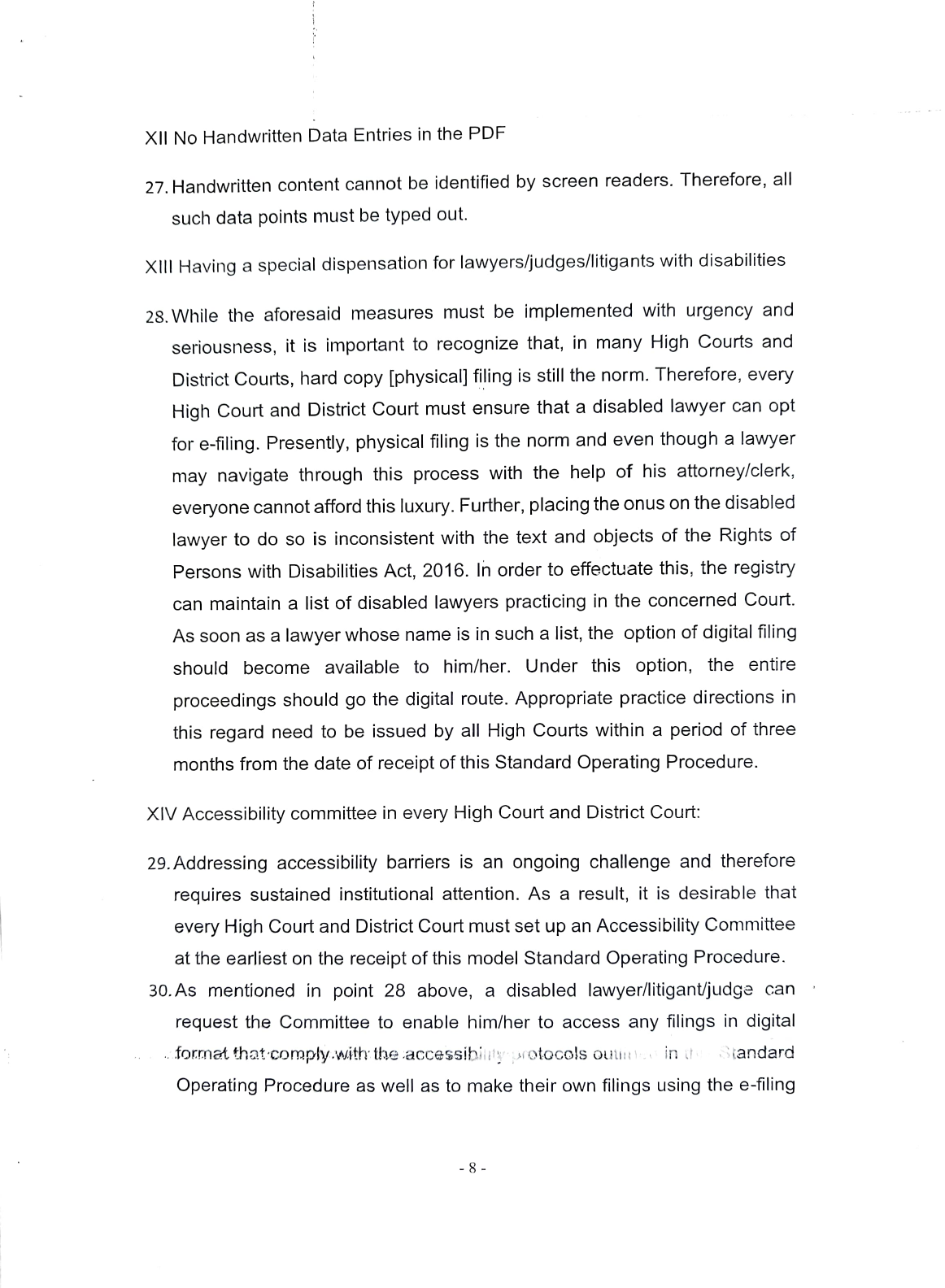
XIl
No
Handwritten
Data
Entries
in
the
PDF
27.
Handwritten content cannot be identified
by
screen readers. Therefore,
all
such data points must be typed out.
XIll
Having
a
special
dispensation
for
lawyers/judges/litigants
with
disabilities
28.
While
the
aforesaid
measures
must
be
implemented
with
urgency
and
seriousness,
it
is
important
to
recognize that,
in
many
High
Courts and
District
Courts,
hard
copy
[physical]
filing
is
still
the
norm.
Therefore,
every
High
Court
and
District
Court
must
ensure
that
a
disabled
lawyer
can
opt
for
e-filing.
Presently,
physical
filing
is
the
norm
and
even
though
a
lawyer
may
navigate
through
this
process
with
the
help
of
his
attorney/clerk,
everyone cannot
afford
this
luxury.
Further,
placing the onus
on
the
disabled
lawyer
to
do
so
is
inconsistent
with
the text and objects
of
the Rights
of
Persons
with
Disabilities
Act,
2016.
In
order
to
effectuate
this,
the
registry
can
maintain
a
list
of
disabled
lawyers
practicing
in
the
concerned
Court.
As
soon
as
a
lawyer
whose
name
is
in
such
a
list,
the
option
of
digital
filing
should
become
available
to
him/her.
Under
this
option,
the
entire
proceedings
should
go
the
digital
route.
Appropriate
practice
directions
in
this
regard
need
to
be
issued
by
all
High
Courts
within
a
period
of
three
months
from
the
date
of
receipt
of
this
Standard
Operating
Procedure.
XIV
Accessibility
committee
in
every
High
Court
and
District
Court:
29.
Addressing
accessibility
barriers
is
an
ongoing
challenge
and
therefore
requires
sustained
institutional
attention.
As
a
result,
it
is
desirable
that
every
High
Court
and
District
Court
must
set
up
an
Accessibility
Committee
at
the
earliest
on
the
receipt
of
this
model
Standard
Operating
Procedure.
30.
As
mentioned
in
point
28
above,
a
disabled
lawyer/litigantjudge
can
request the Committee
to
enable
him/her
to
access
any
filings
in
digital
formaa
hat
compBy.with
he
accessibiiysrotocols
ouH
in
t Siandard
Operating Procedure as
well
as
to
make their
own
filings
using
the
e-filing
- 8 -
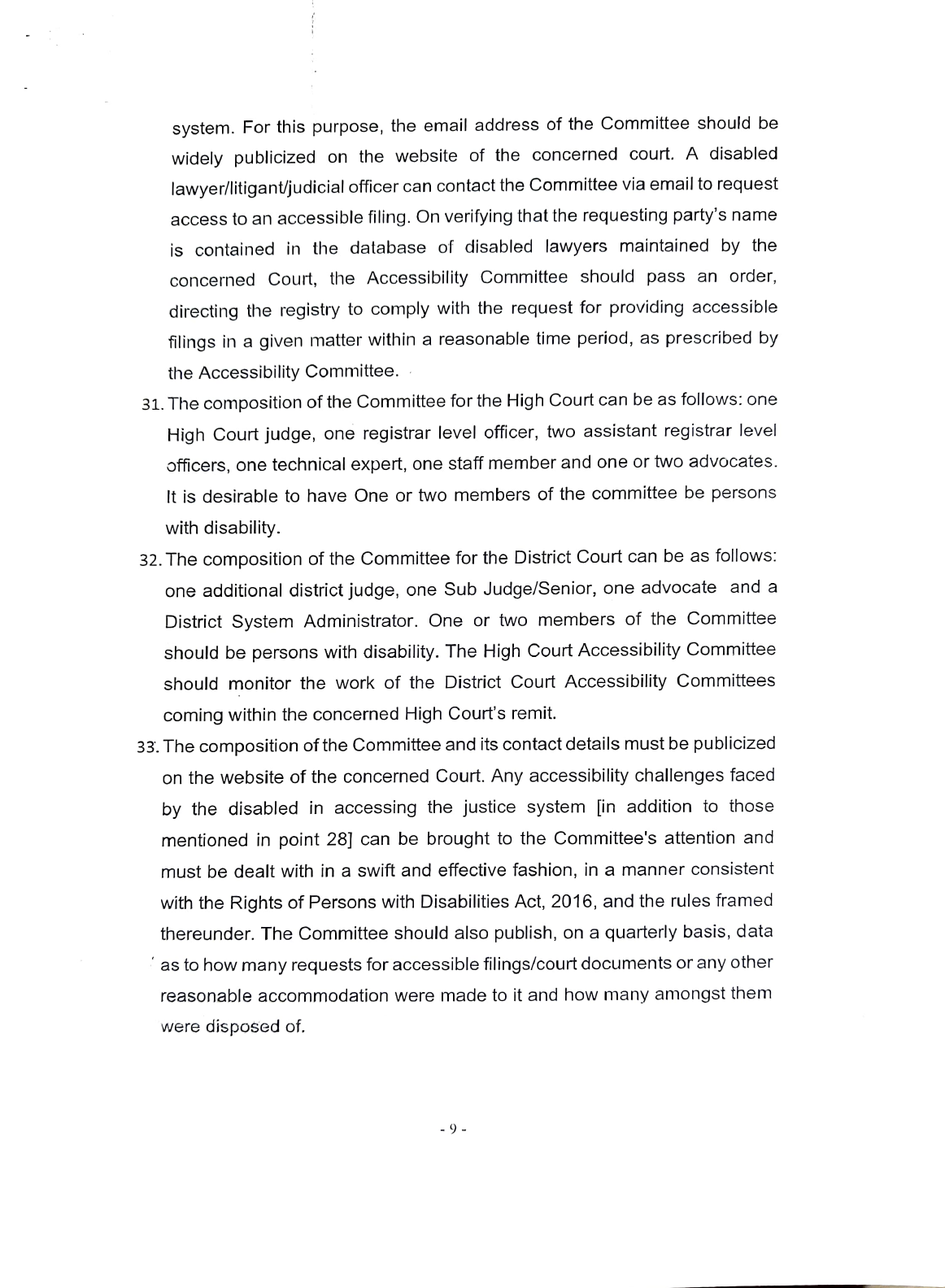
system. For this purpose, the email
address
of
the Committee should be
widely publicized
on
the website
of
the concerned court. A disabled
lawyer/itigant/judicial
officer
can contact the Committee
via
email
to
request
access
to
an
accessible
filing.
On
verifying
that
the
requesting
party's
name
is
contained
in
the
database
of
disabled
lawyers
maintained
by
the
concerned
Court,
the
Accessibility
Committee
should
pass
an
order,
directing
the
registry
to
comply
with
the
request
for
providing
accessible
flings
in
a
given
matter
within
a
reasonable
time
period,
as
prescribed
by
the
Accessibility
Committee.
31.
The
composition
of
the
Commitee
for
the
High
Court
can
be
as
follows:
one
High
Court
judge,
one
registrar
level
officer,
two
assistant
registrar
level
officers,
one
technical
expert,
one
staff
member
and
one
or
two
advocates.
It
is
desirable
to
have
One
or
two
members
of
the
committee
be
persons
with
disability.
32.
The composition
of
the Committee
for
the District Court can be
as
follows:
one
additional
district
judge,
one
Sub
Judge/Senior,
one
advocate
and
a
District
System
Administrato.
One
or
two
members
of
the
Committee
should
be
persons
with
disability.
The
High
Court
Accessibility Committee
should
monitor
the
work
of
the
District
Court
Accessibility Committees
coming
within
the concerned
High
Court's
remit.
33.
The
composition
of
the
Committee
and
its
contact
details
must
be
publicized
on
the
website
of
the
concerned
Court.
Any
accessibility
challenges
faced
by
the
disabled
in
accessing
the
justice
system
[in
addition
to
those
mentioned
in
point
28]
can
be
brought
to
the
Committee's
attention
and
must
be
dealt
with
in
a
swift
and
effective
fashion,
in
a
manner
consistent
with
the
Rights
of
Persons
with
Disabilities
Act,
2016,
and
the
rules
framed
thereunder.
The
Committee
should
also
publish,
on
a
quarterly
basis, data
as
to
how
many
requests
for
accessible
filings/court
documents
or
any
other
reasonable accommodation
were
made
to
it
and
how
many
amongst
them
were disposed
of.
- 9
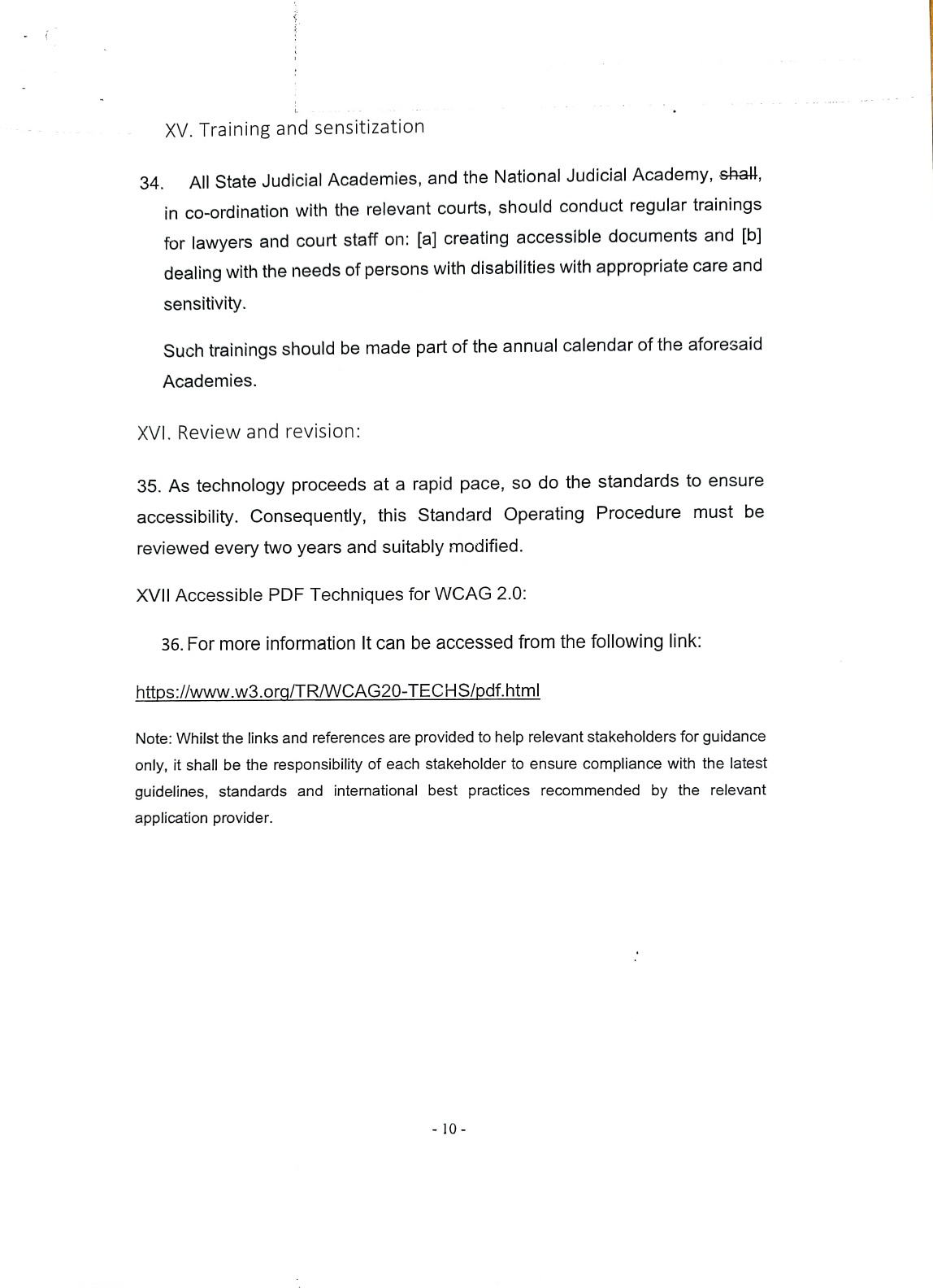
34.
XV.
Training
and
sensitization
All
State
Judicial
Academies,
and
the
National
Judicial
Academy,
shal!,
in
co-ordination
with
the
relevant courts, should conduct regular trainings
for
lawyers
and
court staff
on:
[a] creating accessible documents
and
[b]
dealing
with
the
needs
of
persons
with
disabilities
with
appropriate
care
and
sensitivity.
Such trainings should
be
made part
of
the
annual calendar
of
the aforesaíd
Academies.
XVI.
Review
and
revision:
35.
As
technology proceeds
ata
rapid
pace, so
do
the standards
to
ensure
accessibility.
Consequently,
this
Standard
Operating
Procedure
must
be
reviewed
every
two
years
and
suitably
modified.
XVIl
Accessible
PDF
Techniques
for
WCAG
2.0:
36.
For
more
information
It
can
be
accessed
from
the
following
link:
https://www.w3.org/TRWCAG20-TECHS/pdf.html
Note:
Whilst
the
links
and
references
are
provided
to
help
relevant
stakeholders
for
guidance
only,
it
shall
be
the
responsiblity
of
each
stakeholder
to
ensure
compliance
with
the
latest
guidelines,
standards
and
international
best
practices
recommended
by
the
relevant
application
provider.
- 10 -
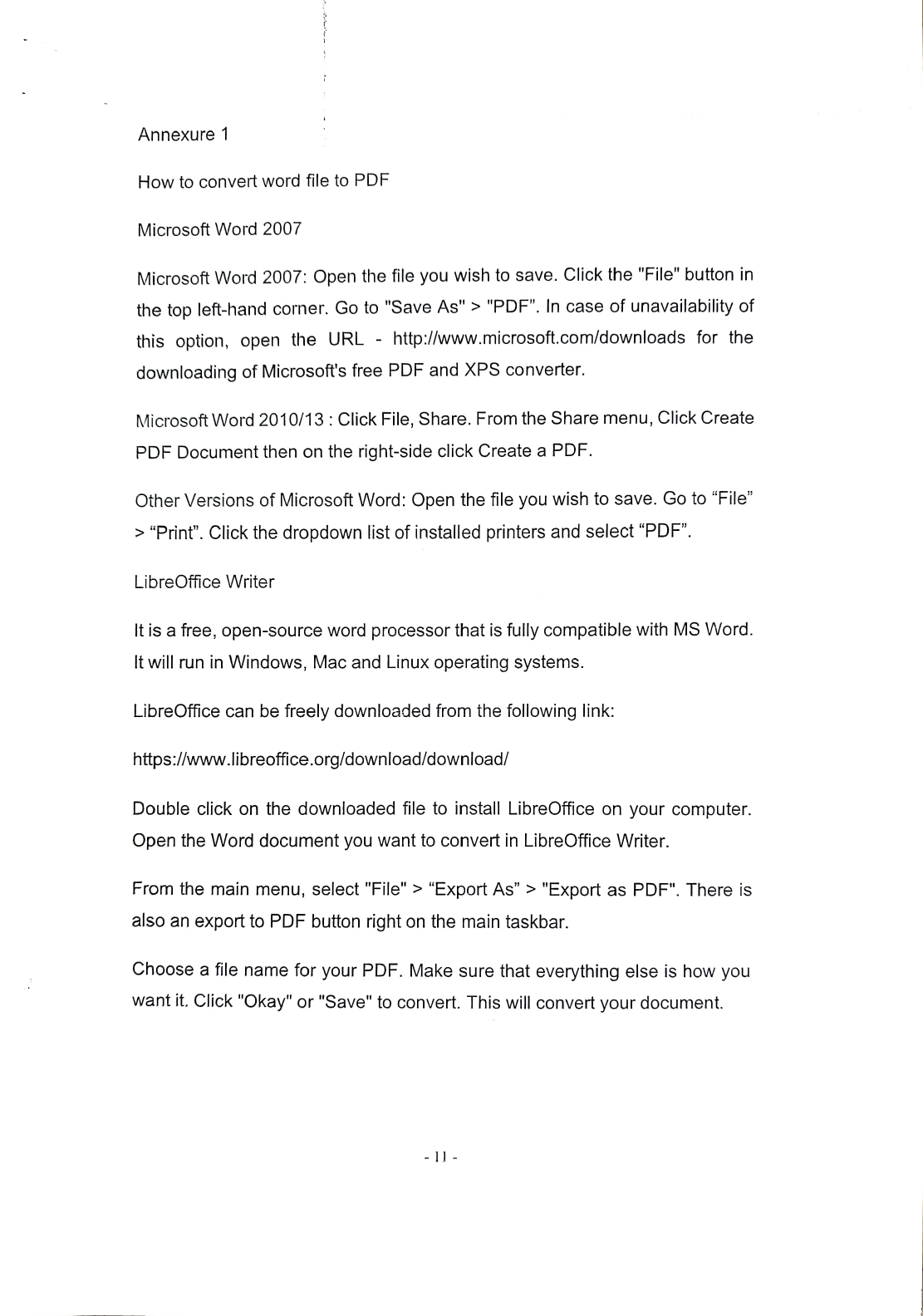
Annexure 1
How to
convert
word
file
to PDF
Microsoft Word
2007
Microsoft
Word
2007:
Open
the
file
you
wish
to
save.
Ciick
the
"File"
button
in
the
top
lef-hand
corner.
Go
to
"Save
As"
>
"PDF".
In
case
of
unavailability
of
this
option,
open
the
URL
- http://www.microsoft.com/downloads
for
the
downloading
of
Microsoft's
free
PDF
and
XPS
converter.
Microsoft
Word
2010/13:
Click
File,
Share.
From
the
Share
menu,
Click
Create
PDF
Document
then
on
the
right-side
click
Create a
PDF.
Other
Versions
of
Microsoft
Word:
Open
the
file
you
wish
to
save.
Go
to
"File"
>
"Print".
Click
the
dropdown
list
of
installed
printers
and
select
"PDF".
LibreOffice Writer
It
is a
free,
open-source
word
processor
that
is
fully
compatible
with
MS
Word.
It
will
run
in
Windows,
Mac
and
Linux
operating
systems.
LibreOffice
can be
freely
downloaded
from
the
following
link:
https://www.libreoffice.org/download/download/
Double
click
on
the
downloaded
file
to
install
LibreOffice
on
your
computer.
Open the
Word
document
you
want
to
convert
in
LibreOffice
Writer.
From
the
main
menu,
select
"File"
>
"Export
As"
>
"Export
as
PDF".
There
is
also
an
export
to
PDF
button
right
on
the
main
taskbar.
Choose
a
fle
name
for
your
PDF.
Make
sure
that
everything
else
is
how
you
want
it.
Click
"Okay"
or
"Save"
to
convert.
This
will
convert
your
document.
-
1]
-
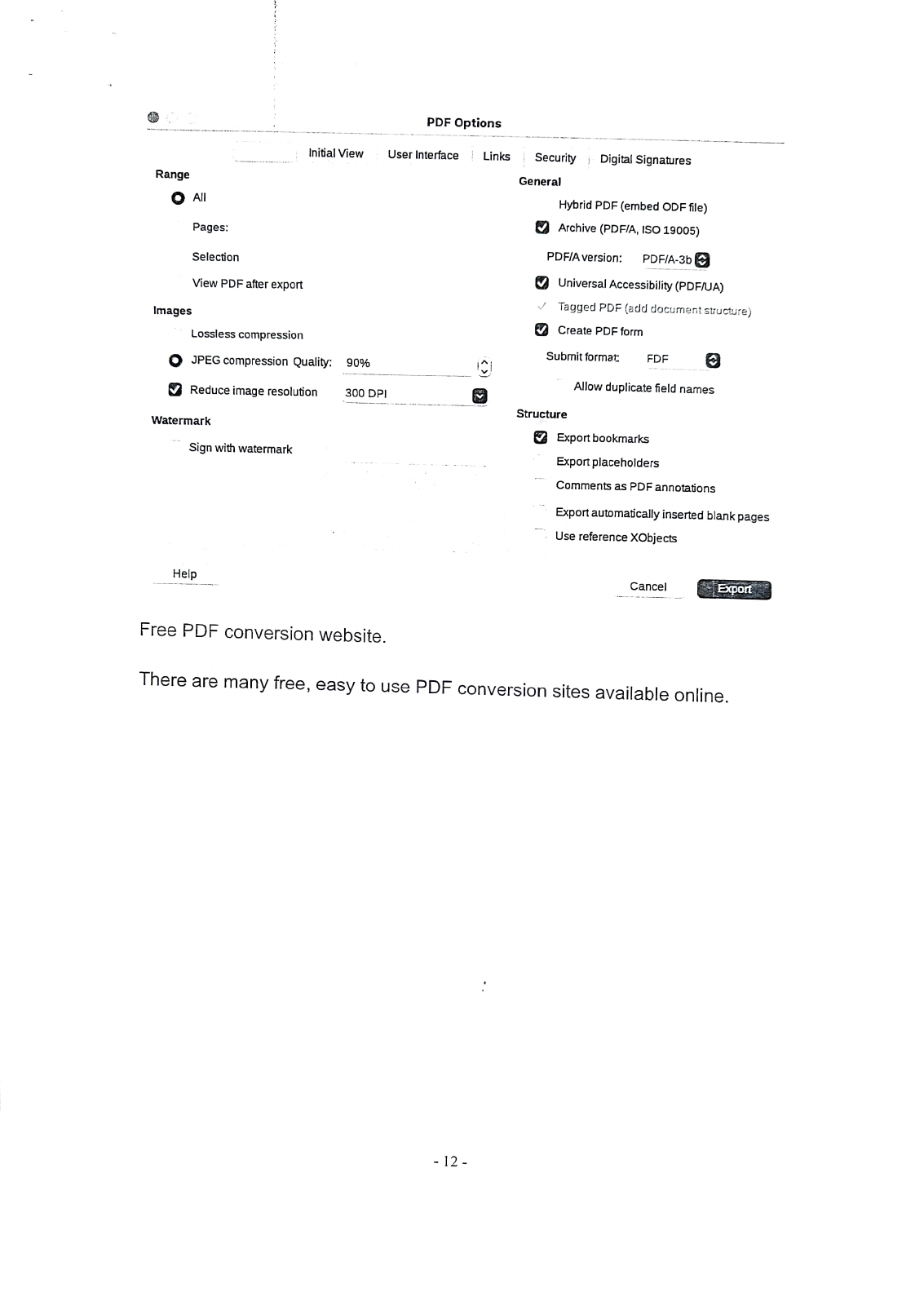
Range
O
All
Images
Pages:
Selection
View
PDF
after
export
Lossless
compression
O
JPEG
compression
Quality:
90%
V
Reduce
image
resolution
Watermark
Iniial
View
Sign
with
watermark
Help
300
DP)
Free
PDF
conversion
website.
PDF
Options
User Interface
Links
- 12
Security
i
Digital
Signatures
General
Hybrid
PDF
(embed
ODF
file)
VArchive
(PDFIA,
ISO
19005)
PDFIAversion:
Universal
Accessibility
(PDF/UA)
Tagged
PDF
(add
document
structure)
Create
PDF
form
PDFIA-3b
Submit
format:
Structure
FDF
Allow
duplicate
field
names
2
Export
bookmarks
Export
placeholders
Comments
as
PDF annotations
Export
automatically
inserted
blank
pages
Use
reference
XObjects
Cancel
Epont
There
are
many
free,
easy
to
use
PDF
conversion
sites
available
online.

Annexure
2
Creating
Accessible
Scanned
Documents
(PDF
Remediation)
PDF
remediation
is
the
process
by
which
digital
information
is
clearly
labelled
(or,
tagged")
and
organized
so
that
people
using
assistive
technology
can
get
the
same
information
from
the
document
that
anyone
would.
It
requires
a
remediation
tool
and
some
understanding
of
remediation
procedures.
Process
of
creating
an
accessible
scanned
document
in
Acrobat
Pro:
()
(i)
(ii)
(iv)
(v)
(vi)
open
image
scanned
document
in
Acrobat
Pro:
perform
OCR
Text
Recognition
and
find
all
OCR
suspect;
add tags
to
the document;
use
Reading
Order
and
Editing
Tools
etc.
and
perform
Full
Check
Features
in
Acrobat
Pro;
if
any errors are found,
fix
them:
if
no
errors are
found,
check
the
document
in
PDF
Accessibility
Software
(PAC3)
for
PDF/UA
compliance;
and
(vii)
if
any errors are
found,
edit
the
document
in
Acrobat
Pro
as per
point
(iv).
Open-Source software
for
PDF
Remediation:
OCRMYPDF
OCRMYPDF
adds
an
optical
character
recognition
(OCR)
text
layer
to
scanned
PDF
files,
allowing
them
to
be
searched.
It
is
working
as a
terminal
application.
Basic
knowledge
of
terminal
usage
is
required
for
using
this
software
application.
A.
Installation:
In
Ubuntu
20.04
sudo
apt
install
ocrmypdf
- 13
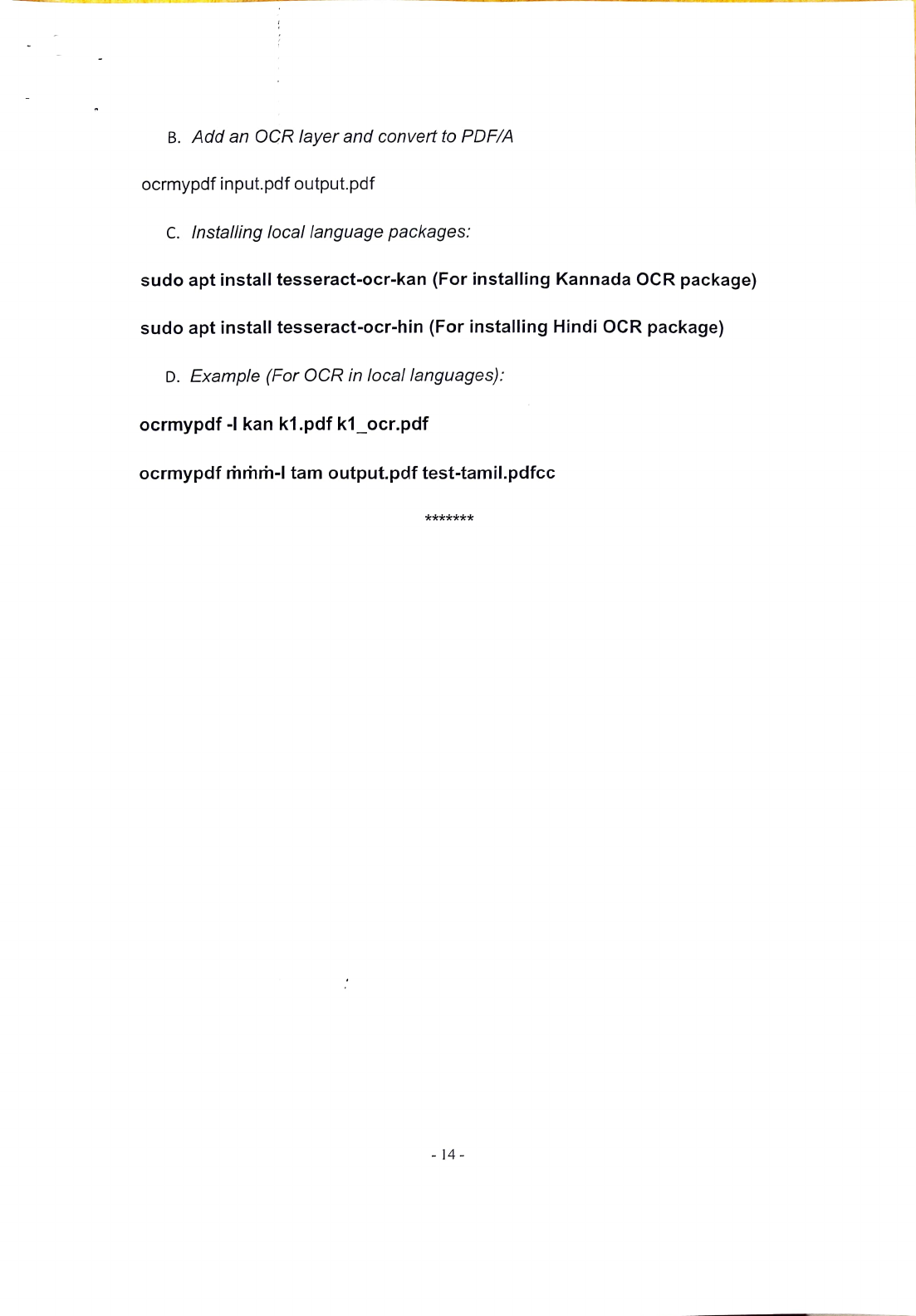
B.
Add
an
OCR
layer and convert
to
PDFIA
ocrmypdf
input.pdf
output.pdf
C.
Installing
local
language packages:
sudo apt install tesseract-ocr-kan (For installing Kannada
OCR
package)
sudo
apt
install
tesseract-ocr-hin
(For
installing
Hindi
OCR
package)
D.
Example
(For
OCR
in
local
languages):
ocrmypdf -
kan
k1.pdf
k1_ocr.pdf
ocrmypdf
rmrirn-l
tam
output.pdf
test-tamil.pdfcc
- J4
